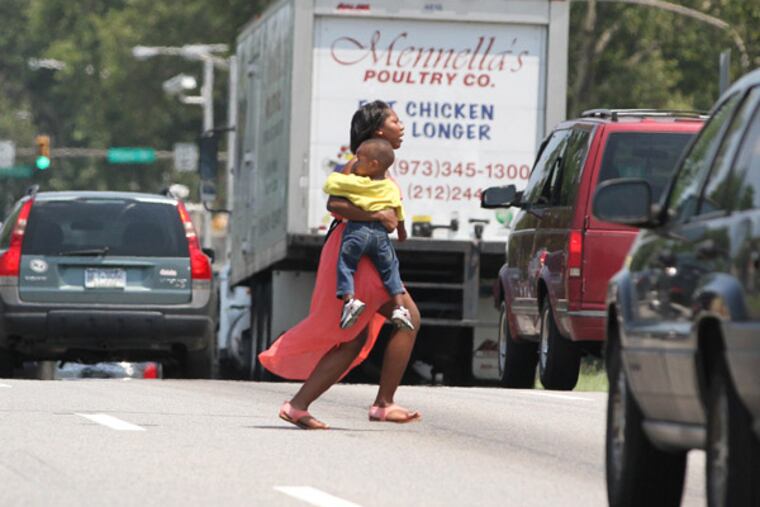Phila. trails in issuing jaywalking tickets
In Philadelphia's stepped-up efforts to reduce pedestrian deaths and injuries, one tactic has not been used: Issuing tickets to scofflaw pedestrians.

In Philadelphia's stepped-up efforts to reduce pedestrian deaths and injuries, one tactic has not been used: Issuing tickets to scofflaw pedestrians.
So far this year, Philadelphia police have cited no one for jaywalking.
That follows a historic pattern. On average, city police issue about nine jaywalking tickets a year, according to the department's records.
By comparison, San Diego issued 328 jaywalking tickets in a single day last year. Los Angeles police issued more than 31,000 jaywalking citations last year in that city's Central Bureau, an area of about 900,000 people.
Even in New York City, where police have traditionally turned a blind eye to pedestrian violations, 64 jaywalking tickets were issued in the first three weeks of this year, compared with 12 in the same period last year. New York Mayor Bill de Blasio has stepped up efforts to reduce pedestrian and traffic deaths.
In Philadelphia, pedestrian deaths and injuries have been a persistent problem, with 37 pedestrians killed in 2013 and 1,796 injured.
In the last five years, 162 pedestrians have been killed in Philadelphia and 8,919 injured by vehicles, according to the Pennsylvania Department of Transportation.
Pedestrians represent a much larger share of traffic fatalities in Philadelphia than in the nation as a whole: In 2012, 32 percent of people killed in traffic accidents in Philadelphia were pedestrians, compared with 14 percent nationwide.
To combat the problem, red-light cameras have been installed at 26 Philadelphia intersections, and state legislators are considering a bill to authorize speed-enforcement cameras on Roosevelt Boulevard, the notoriously dangerous 12-lane highway in Northeast Philadelphia.
And last month, the city won a $525,000 grant from the U.S. Department of Transportation to "expand pedestrian safety education and enforcement efforts."
Philadelphia was one of only three cities in the nation (along with New York and Louisville, Ky.) to receive such a grant from among dozens that applied.
"These funds are going to help make Philadelphia a national model for pedestrian safety efforts," Mayor Nutter said last month.
The money will be used for educational advertising, a new police training video, and safe-walking programs for Philadelphia second-graders, said Andrew Stober, chief of staff to Rina Cutler, deputy mayor for transportation.
The city will also increase police enforcement against "driving behaviors that endanger pedestrians the most," such as speeding, red-light-running, and illegal right turns, Stober said.
So far, though, one weapon the city has not used is the jaywalking ticket, to discourage pedestrians from crossing against a light or in mid-block.
In Philadelphia, pedestrians routinely ignore red lights and "don't walk" signals, and are as likely to cross in the middle of a block as at a crosswalk.
Distracted walking has also become a growing problem.
"You see people just walk into the street looking at their iPhones," Stober said.
The difference between pedestrian behavior in Philadelphia and California cities such as Los Angeles "is very much a cultural issue," said Stober.
"In the West, in places like L.A. where the car is king, it reflects a different approach to safety," he said, noting that streets also tend to be wider in Western cities than in Philadelphia's colonial grid.
City police say they have better things to do than ticket pedestrians.
Police spokesman Lt. John Stanford said police have concentrated on reducing vehicle speeds, and on educating "both motorists and pedestrians on safety issues."
"Unfortunately, we have some areas where we must focus on criminal activity and therefore we can't focus solely on jaywalking," Stanford said. "Our concern to make the city safe is paramount, and we will continue to explore all options."